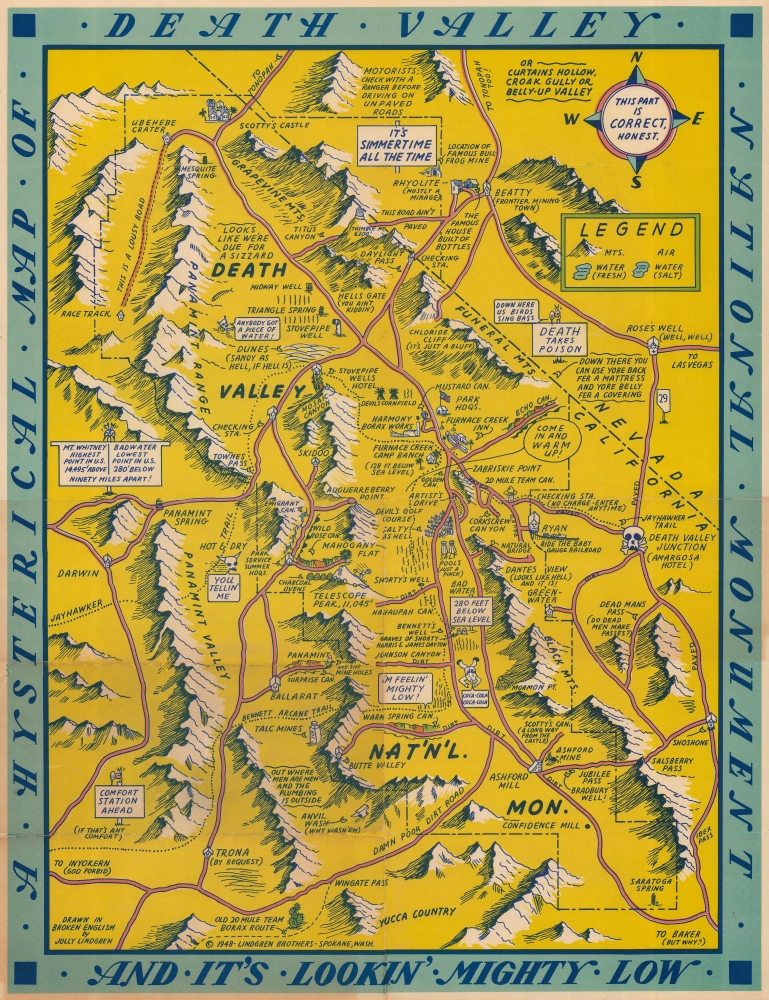1948 Lindgren Humorous Pictorial Map of Death Valley National Monument
DeathValleyNM-lindgren-1948
Title
1948 (dated) 21.25 x 16.25 in (53.975 x 41.275 cm)
Description
A Closer Look
'Hysterical' vignettes and captions throughout provide humorous commentary on Death Valley. A bleached animal skull appears beneath the phrase 'hot and dry' and provides the comment 'you tellin' me' not far from another skeletal creature screaming 'Anybody got a piece of water!'. A tourist on his belly pants for a Coca-Cola. Lindgren identifies Dead Man's Pass outside the park and says as an aside 'Do dead men make passes?' The subtitle for the map is 'Or Curtains Hollow, Croak Gully, or Belly-Up Valley'. A road between Ubehebe Crater and Race Track is labeled simply as 'This is a lousy road'.On the more serious side, Lindgren marks hotels and other important locations. He identifies mines and landmarks both inside and outside the park. Also, written in prominent lettering at top center is the warning 'Motorists: Check with a Ranger before driving on unpaved roads'.
Death Valley National Park
On February 11, 1933, President Herbert Hoover created a nearly two-million-acre national monument in Death Valley. The Civilian Conservation Corps was responsible for the earliest improvements to the park, grading 500 miles of roads, installing telegraph and water lines, and constructing seventy-six buildings. Designated a biosphere reserve in 1994, Death Valley National Monument was expanded by 1.3 million acres on October 31, 1994, and redesignated as Death Valley National Park - the largest national park in the contiguous United States.Lindgren's 'Hysterical' Maps
Between roughly 1930 and 1950, Hjalmer 'Jolly' Lindgren (1895 - September 1952) and his brother Oscar 'Ott' Lindgren (1893 - 1967) issued a series of 'Hysterical Maps' detailing American national parks and monuments. Jolly was the artist while his brother, Oscar, ran the business side. Jolly imagined the maps as comic relief, as well as a reminder of the world's most beautiful places during both the Great Depression and the subsequent World War II (1939 - 1945) era. He wrote, 'What this country needs now is something to put a smile on people’s faces.' The maps are graphically interesting and intended, as the titles suggest, to amuse. The brothers focused on producing maps of popular tourist attractions, and the great national parks of the West were an obvious choice. They produced maps of Yellowstone, the Grand Canyon, Glacier, Zion, Bryce Canyon and others through the early 1940s. Some were also issued as postcards. Today, Lindgren's larger maps are highly desirable, and many are extremely rare. There is no complete census of Lindgren's full corpus.Publication History and Census/h6>This map was created by Jolly Lindgren and published by Lindgren Brothers in 1948. We note three examples cataloged in OCLC which are part of the collections at the Library of Congress, the University of Wyoming, and the David Rumsey Map Collection at Stanford University. Only a handful of examples have appeared on the market in recent years, making this one of the hardest-to-find Lindgren maps.
Cartographer
Lindgren Brothers (1928 – 1971) was a Spokane, Washington, based printer known for issuing humorous souvenir auto decals, maps, and posters. The firm was founded as a sign-painting company by Hjalmer 'Jolly' Lindgren (1895 - September 1952) and his brother Oscar 'Ott' Lindgren (1893 - 1967), born in Wisconsin to Swedish immigrants. Neither brother had middle names when they went off to fight in World War I (1914 - 1818), but as the government required it, they adopted Jolly and Ott, which stuck with them for life. Jolly was in charge of the art department and Ott was in charge of the business aspects of the firm. The company began as printers and sign makers, and also became innovators in silkscreen printing, and as the Great Depression deepened, Jolly began producing 'hysterical maps'. He declared at the time, ‘What this country needs now is something to put a smile on people's faces.' The maps are graphically interesting and intended, as the titles suggest, to amuse. The brothers focused on producing maps of popular tourist attractions, and the great national parks of the West were an obvious choice. They produced maps of Yellowstone, the Grand Canyon, Glacier, Zion, Bryce Canyon and others through the early 1940s. Following a hiatus during World War II (1939 - 1945), the company began producing car decals, some of which were simplified versions of the ‘hysterical maps'. The company sold more than ten million decals in a good year. In 1949, the company was renamed the Lindgren-Turner Company when their traveling salesman, Theodore 'Ted' Turner, Jr. (1902 - 1989), who had been with the firm since 1930, became a partner. Jolly died unexpectedly at 57 while visiting his daughter in Boise, Idaho. The firm continued under his brother, Oscar. William Shigeo Terao (1915 - 1990), who was hired after World War II by the Lindgrens and eventually became the firm's art director, created two more hysterical maps following Jolly's death. The company's last great success, after the decal market had become too competitive, was a sign that read 'No Trespassing, Survivors will be Prosecuted'. The signs became a massive success, eventually being sold in every Woolworth's department store nationwide - all 2,228 locations. Ott died in 1967 at the age of 74, leaving Turner as the last member of the original team. He, in turn, sold the firm to the Emblem Manufacturing Company based in Los Angeles, in February 1971 and he and his wife moved to New Mexico three years later to be closer to their daughter. Turner wrote a history of the Lindgren-Turner Company during his retirement and died at the age of 87 in 1989. More by this mapmaker...

